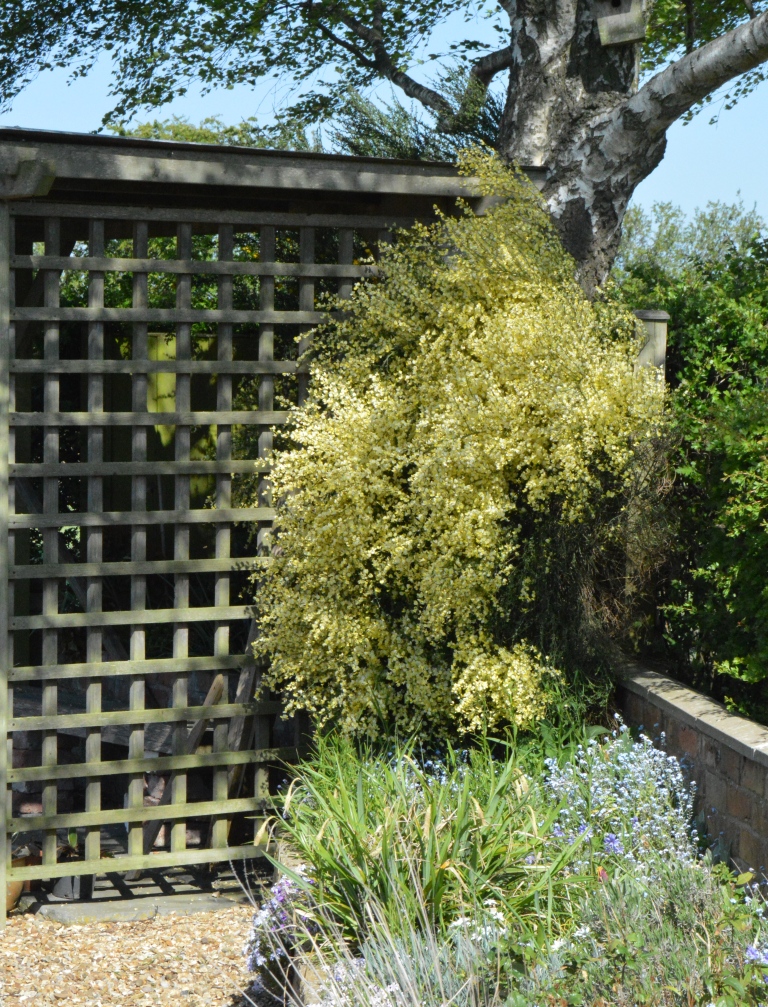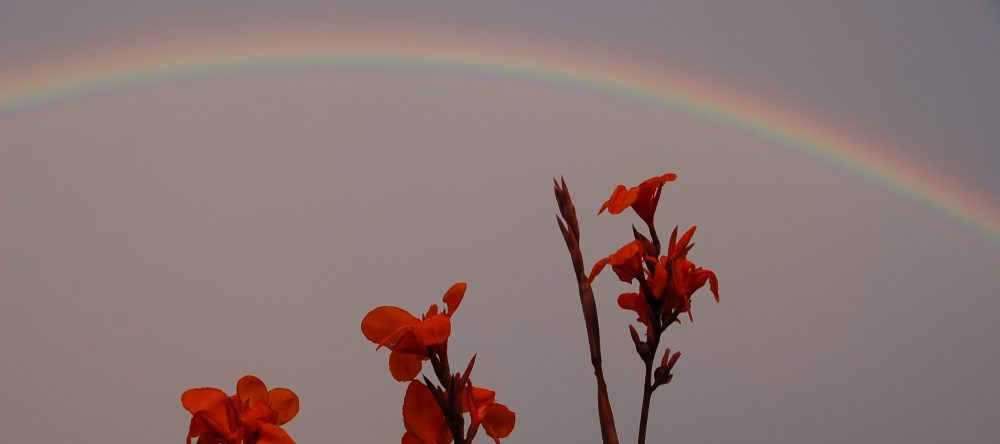For the past few years I’ve written about a prolonged drought at spring – a time when you wouldn’t necessarily expect it. I wondered whether it was just in the Vale of Glamorgan, where I was living until last December. But now I’m in Shropshire, and this year’s drought is like nothing I can remember. Grass is going brown. The 250 litre water butt we installed a few months ago has long since been emptied. And the pond is becoming little more than a muddy puddle…

The alpine flowers look pretty reflected in the water, even if the surface is a bit messy. We inherited the pond, the bridge and an artificial hill with an imitation mountain stream waterfall. Not really our style, but I have to admit that at this time of year the alpine flowers look wonderful…

The darker blue flowers are Lithodora ‘Heavenly Blue’, but beyond that, and the heathers, I’m not sure – alpines are not plants I’ve ever taken much interest in. I suspect there are some alpine phlox in there. They don’t seem to mind the dry weather.

We haven’t had any significant rain for many weeks. Added to that, it’s been mostly sunny, and there’s been a strong, desiccating wind (my OED says ‘desiccative’, but WordPress isn’t so fussy). Not the greatest conditions in which to be creating a new garden. I’ve been moving turf around to set out the beds and the grassy areas, but struggling to stop them drying up altogether. Watering has been a major job, particularly as most of the plants we brought with us are still in pots.

I’m ashamed to say I’ve lost a few, including a small cutting of a fig, some phlox (the border type, rather than alpine varieties), and a yellow bottlebrush/wattle called Melaleuca squarrosa, which was one of a few grown from seed brought back from Australia). The one we planted in our last garden was around seven feet tall by the time we left, but we don’t have any left now. Maybe that’s an excuse to go and buy some more seeds, if ever we’re allowed to travel again.
The plants we bought from Burncoose nursery are all in now, and seem to be hanging on, with regular watering. The buds of the two upright beech trees are swelling and elongating, and I’m looking forward to them opening. The six fruit trees in our mini orchard have been in for longer and are also doing okay. This is Malus (apple!) ‘James Grieve’…

In the raised bed at the end (which will eventually be moved later on in the implementation of my garden plan) we’ve already harvested some of the rhubarb, and the reset strawberry plants are beginning to flower among the rubble…

I’ve been cavalier in moving rhododendrons that were in the way, but they’re coming out now, and I have to admit they are impressive. I may try harder to accommodate them under, and among the structural trees and shrubs in the design. The rich red will really shine out from the understorey. I’m almost excited to see what colours some of the others will be. I hope they survive, though some will need to be moved again, once they’ve finished flowering, and our thin soil is going to need some significant bulking up with organic material if they are to really thrive.

I was initially delighted to discover we had soil that is so easy to work. But in the last few weeks, with the continuing dry, sunny, windy conditions, I’ve seen just how thin it is. The tractors working in the field have raised dust storms, and as I clear more areas of grass and weeds I’ve taken to covering the exposed soil, for fear it will all blow away. It really is a bit like the mid-west here. All we need is some tumble weed. On the plus side, I am looking forward to growing a range of different plants from those I’ve been used to. Echinacea, for instance, and heleniums, which typically didn’t last the winter in the heavy clay of our last garden. Broom seems to do very well here – we have three large plants in the garden, and they are all full of flower, giving off a distinctive, heady aroma. Who needs Chanel?

And the magnolia is finally in full flower. I’m not sure of the variety. Despite having plenty of flowers, it’s something of a disappointment. Magnolia flowers can be damaged by frost; normally it’s the ones that flower early that suffer most. Despite flowering late, many of the flowers on our magnolia are frost damaged, with brown, rotten patches. Those flowers that aren’t affected look good though.

Here’s the full picture…

Actually, it doesn’t look to bad from a distance. It needs some structural pruning to improve the shape. The stems are crossing and congested. There’s another job waiting to be done. I’ll let it finish flowering first.
text & images © graham wright
